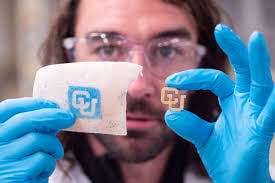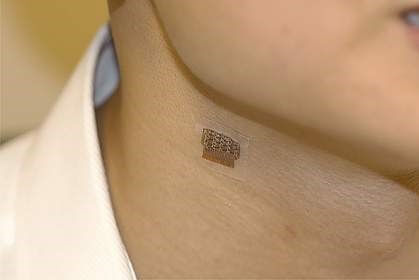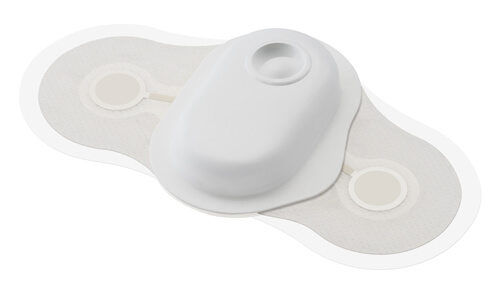Will these new tech replace blood tests and other diagnostic tools?
Key Takeaways
Can you imagine a tattoo that changes color according to changes in your body? Or underwear that continuously monitors those changes? Researchers are working on just such innovations in the wearable medical technology field, toward the ultimate goal of quick and personalized 24/7 monitoring to improve health, while making doing so easy on both patients and physicians.
Here are a few developments in the wearable medical technology field that are sure to launch medicine into the future.
Color-changing tech tattoos

Photo credit: Glenn Asakawa/CU Boulder
Carson Bruns, PhD, assistant professor and chemist, Department of Mechanical Engineering, ATLAS Institute, University of Colorado Boulder, Boulder, CO, and colleagues are studying "tech tattoos" that change color in response to various signals from the body. Based on recent research, they have developed a prototype tech tattoo that vanishes and reappears according to temperature changes, which may act as a built-in thermometer.
According to Dr. Bruns, these types of "smart" tattoos may one day change medicine by signaling fevers or other medical conditions without the need for expensive blood tests.
Dr. Bruns is not only a chemist but an amateur painter and tattoo artist. With his latest endeavor, he has attempted to bring these fields together.
Along with graduate student Jesse Butterfield, Dr. Bruns has succeeded in encasing tattoo dyes in miniscule plastic microcapsules, smaller than the width of a human hair. The dyes are protected by the capsules from deterioration but can still sense changes in the surrounding environment (ie, the body) and adapt accordingly. These inks can be applied to the skin with the same needles used by tattoo artists.
"When you think about what a tattoo is, it's just a bunch of particles that sit in your skin," said Dr. Bruns. "Our thought is: What if we use nanotechnology to give these particles some function?"
Dr. Bruns and Butterfield have experimented with tech tattoos made of commercially available dyes visible only when exposed to UV rays. These tattoos, which Dr. Bruns calls "solar freckles," could help signal, for example, when your sunscreen needs reapplication.
"If you were to put sunscreen over this tattoo, it would disappear, even in the sunlight," Dr. Bruns said. "When your sunscreen wears off, it would reappear, giving you a reminder that you need to reapply your sunscreen."
Almost any kind of dye could work with this approach, according to Dr. Bruns, and the tattoos can have functions outside of UV detection. Possibilities include tattoos that track blood alcohol or blood glucose levels.
Their research is ongoing, but Dr. Bruns has willingly given himself solar freckles (two blue dots on his forearm) to see if they work.
Smartphone app screens for anemia

A smartphone selfie of the fingernail may soon help those with suspected anemia verify whether they are anemic. People with chronic anemia may also use the technology to monitor their condition. Researchers at Emory University, Atlanta, GA, have developed an algorithm to detect signs of anemia simply from the coloration of the nailbed.
The new app, currently under development, uses a form of artificial intelligence to determine levels of hemoglobin simply through assessing the color of a person's nailbed. The app estimates hemoglobin levels by analyzing color and metadata from smartphone photos of the fingernail bed.
When the app was tested on 100 volunteers, it had a sensitivity of 97% compared with CBC hemoglobin levels and an accuracy of ± 2.4 g/dL-1.
Wearable sensor detects pH

Photo credit: University of Glasgow
Researchers from the University of Glasgow, Glasgow, Scotland, are working on a new stretchable, wearable sensor that may replace blood tests to measure glucose, sodium, and potassium levels. The new sensor was developed based on the understanding that data capturable from sweat is equivalent to that of a blood test because sweat (and tears) contain similar biomarkers.
This unique wearable is comprised of a pH sensor made from a graphite-polyurethane composite, and contains a stretchable radio-frequency-identification antenna and a flexible data-transmission printed circuit board. The sensor is 1 cm2 and can stretch up to 53% in length via a pair of serpentine-shaped, interconnected pieces.
The sensor measures the patient's pH levels through their sweat and then transmits the data to the patient's smartphone for real-time monitoring on the SenseAble app, developed by the research team. The sensor responds to pH levels between 5 and 9, and provides results within 8 seconds. The sensor's reliability is up to 20% strain.
Currently, the sensor measures only pH levels, but researchers hope to expand the technology to allow patients to monitor glucose, ammonia, and urea levels in the future.
Wearable ultrasound patches

Photo credit: Chonghe Wang/Nature Biomedical Engineering
Researchers at the University of California, San Diego, San Diego, CA, are developing a thin, wearable blood pressure sensor using ultrasound transducers. This flexible, stretchy device—similar to a bandage—can be worn on the skin. An array of ultrasound transducers is arranged within the patch, allowing for positioning that allows for one of the transducers to be placed directly over an artery. A layer of silicone on the underside of the patch takes the place of ultrasound gel. The transducers then create a waveform representative of the patient's central blood pressure. They are effective for vessels that are located as deep as 4 cm underneath the surface of the skin.
The applications of such a technology include the continuous blood pressure monitoring in critically ill patients, those with heart and lung disease, or patients scheduled to undergo surgery, especially cardiopulmonary procedures, when accurate, real-time blood pressure measurement is necessary.
7-day wearable ECG sensor

Photo courtesy: Welch Allyn
The TAGecg sensor (manufactured by Welch Allyn), currently available on the market, is a continuous, wearable, 7-day ECG recorder that enables the detection of arrhythmias, such as atrial fibrillation and flutter. The sensor makes it convenient for physicians to detect arrhythmias in the office.
Placement of the sensor allows for 7-day monitoring of patients, who can simply go about their daily lives with no disruptions. The sensor is small and lightweight, with a single-lead continuous ECG sensor that is discrete, wireless, and water-resistant. It has a positive predictive value of over 98% in detecting atrial fibrillation and flutter, and a sensitivity of 96%.
When the patient returns to the office and the monitor is plugged into the software, a report is immediately generated for the physician, who can then analyze and interpret the results without the need for a third-party reader or dedicated staff.
MDLinx has no financial interest in any of the products mentioned.